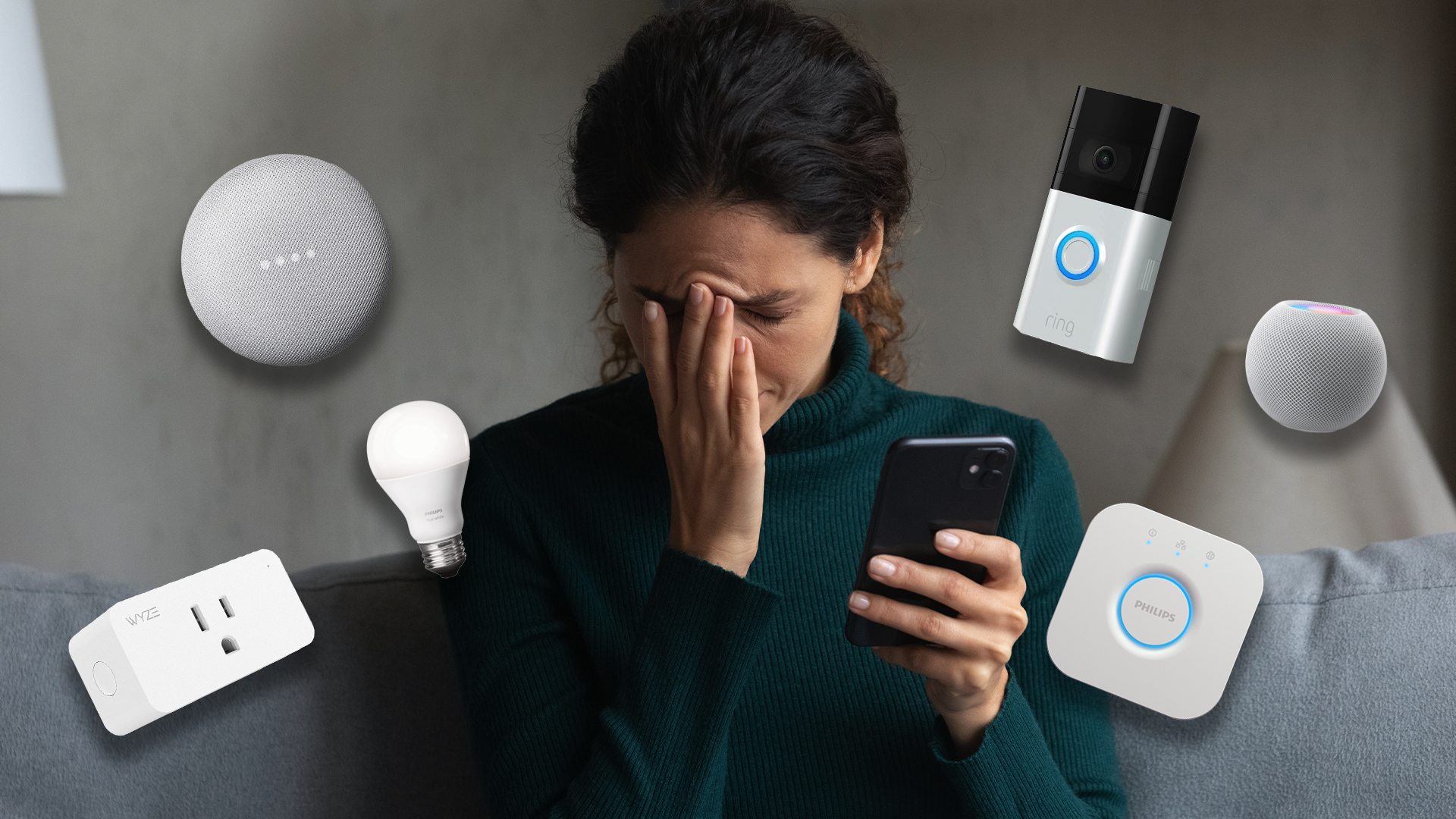I’ve been messing around with smart home tech for longer than I care to admit, and it’s brought me hours of pleasure. Having the perfect smart home automation that makes your life a little bit easier is wonderful, but the process of creating it is arguably even more satisfying.
That’s not to say that it’s all fun and games. Several things drive me insane about my smart home on a regular basis. Fortunately, it’s possible to mitigate at least some of them.
1
Automations Can Have a Mind of Their Own
Smart home automation can feel like magic. That is, until they stop doing what you want them to do and start doing something else entirely. There’s nothing more frustrating than creating what you think is the perfect automation, only to find that sometimes it works, but other times it does something completely unexpected that you didn’t ask it to do.
For example, I created an iOS shortcut that berates me every five minutes that I stay on Reddit, with a snarky message generated by AI. Most of the time, it works as expected, but occasionally, it keeps running even when I’ve closed Reddit, calling me out for using an app that I don’t even have open.
Unfortunately, there’s no easy fix for these types of problems. You can reduce the risk of them happening in the first place by making your automations as simple as possible; the more complex they get, the more chance there is for something to go wrong.
Testing your automation before you start using it is also definitely recommended. Try a few different scenarios that are likely to occur to see if the automation holds up. Most importantly, log everything so that if something does go wrong, you can look through the logs to see exactly what happened and why.
Sometimes, the problem isn’t your automation but the limitations of the platform. With my doomscrolling shortcut, the problem appears to lie with the fact that the “Wait” action doesn’t work for times of more than a minute or two; beyond that, things start to fall apart. In cases like this, you just have to find another way of achieving what you want to do or live with the occasional error.
2
Voice Assistants Are Idiots
Siri has been around since 2010. When the voice assistant first launched, it was genuinely exciting, and felt like the future had arrived. 15 years later, and Siri still misunderstands the most basic commands.
Alexa followed in 2014, and we’re still waiting for Alexa+ to arrive, with the current model still being frustrating to use. I have to say my wake word (Computer, obviously) in a strange accent to get it to respond most of the time.
After a decade and more of voice assistants, you would think that they would have reached the point where when you ask to play music, they don’t start calling your mom, but sadly, that’s still the case. The experience is mostly just incredibly frustrating.
Unfortunately, there’s not a huge deal that can be done to fix this until the voice assistants themselves are improved. An updated version of Siri and Alexa are supposed to be coming, but they keep being pushed back, which doesn’t fill me with confidence about how good they will be in real life.
There are things you can do to try to improve your results. With Siri, you can create shortcuts with specific names, then use these names with Siri, which can be more successful, as long as Siri hears you correctly. You can try creating vocal shortcuts that run without you needing to say “Hey Siri,” but these are far from perfect, either.
You can try running your own voice assistant that uses an LLM to interpret your queries, but the issue is still having a device that you can trigger with a wake word that works consistently. Home Assistant has released a prototype of its own voice assistant hardware, but as yet, it still has many of the same issues. For now, all we can do is wait for things to improve.
3
Things Always Break at the Most Inconvenient Times
The reality is that this probably isn’t the case, but it always feels like things break at the worst possible moment. My video doorbell automation will describe who is at the door for every single person that arrives, until it’s that one really important caller, and then it simply does nothing. My remote control automation will stop working the moment I sit down to watch TV in the evening and then start working again just as I’m about to get up to go to bed.
The reality is that things break all the time, and you simply notice them more when they cause more inconvenience. I still wish things would work when I need them the most, however. There are a few things you can do to try to improve the situation.
Choosing reliable hardware is a good start. If your devices regularly go down, then it’s inevitably going to happen when you really need them at some point. A stable communication network is also key; if your devices drop off Wi-Fi or your Zigbee network, then your automations have no data to work with.
Regular maintenance can also help. Making sure devices are charged, have the batteries replaced, or have up-to-date firmware can keep things running more smoothly.
4
The Dreaded Spouse Approval Factor
This is the bane of every tinkerer’s life. You spend days working on the perfect automation that will make life in your home significantly better. The trouble is that it involves a minor bit of input from the people in your home to make it work. Your spouse uses their power of veto, and you’re not allowed to keep the automation running; your automation does not have the spouse approval factor (SAF).
It’s all too easy to work around problems with your automations with hacks that you can remember without a problem but make things unnecessarily complicated for other people to use. If it doesn’t “just work,” then the people you live with are unlikely to approve. It’s no good telling everyone to leave the light switches powered on so your smart bulbs will work; someone is going to turn them off at some point.
Your automations can gain the SAF if they work seamlessly without requiring any input or if the input is simple and easy to remember. Otherwise, you may start to hear complaints. A useful piece of advice is to discuss the plans for your automations with the people that you live with before you implement them. That way, everyone is invested, and you’ll know before you put in the hours whether other people will approve of them.
It’s also worthwhile to slowly add automations to your home so that people have time to get used to them, rather than dropping a whole bunch at once. The key thing to remember is that if the automations make everyone’s lives easier, they will gain approval. If they make things more complicated, they won’t.
5
Updates That Destroy Everything
Updates are great. When you update your smart home software, you may gain access to shiny new features that allow you to automate even more of your home. However, updates can come at a price.
Updates can often bring breaking changes, which will stop some of your current automations from working. You gain new features, but you also lose some of your current functionality. You then have to go through your automations fixing what’s now broken.
Turning off automatic updates is a good place to start. Allow software to update before you’ve had a chance to read the release notes and find out what it’s going to break can often end badly. If a release is going to destroy a lot of your automations, you might want to get the fixes in place before you update.
It’s also worth staggering your updates. If you have multiple devices that have new firmware available, you can try updating one of them first to see if it destroys everything. That way, your other devices will still be working.
The safest thing to do is to have a rollback plan. If it’s possible to revert to a previous version, then ensure that you’re prepared to do so. That will give you time to work on how to fix the problems before attempting to update again.
6
I Have Nightmares at the Thought of Guests Visiting
Imagine that by some miracle, you’ve managed to persuade the people you live with to never touch the light switches and just let your perfectly crafted presence detection automations do their job. All is good in the world until guests arrive.
The trouble with guests is that they expect your home to work like any normal home should, not realizing that they mustn’t touch the TV remote if they want to watch TV because it will destroy everything.
The best mitigation for this is to create a Guest Mode that you can activate when people visit. In Guest Mode, all of your automations that require people in your home to follow specific behaviors can be turned off, leaving a home that works mostly like you would expect.
For example, you can disable your motion-activated lighting and have your lights respond to the power switches in the usual way. That way, they may actually come back again, rather than running away in fear of your strange home that doesn’t work properly.
7
I Just Can’t Stop Tinkering
This is the thing that drives me mad the most about my smart home. No matter how much of it I automate, it will never be enough. That’s the joy of tinkering; the journey is arguably more fun than the destination. Even if my smart home does everything I could ever want it to, I will always want to try something else.
Unfortunately, there’s no known cure for this disease other than running out of money to buy more smart tech. All I can do is try to keep my tinkering to levels that fall just short of being legitimate grounds for divorce.
Messing around with smart tech is fun. Sure, some of the automations I create are genuinely useful, but many of them fall firmly in the “just because I can” category. That’s the point of tinkering, though; it’s meant to be fun.
Sometimes, my smart home can drive me mad. However, there are usually ways to remove or reduce these problems if I really put my mind to it. Solving these problems can often bring their own sense of joy, too. Now I just need to find a cure for upgraditis…











